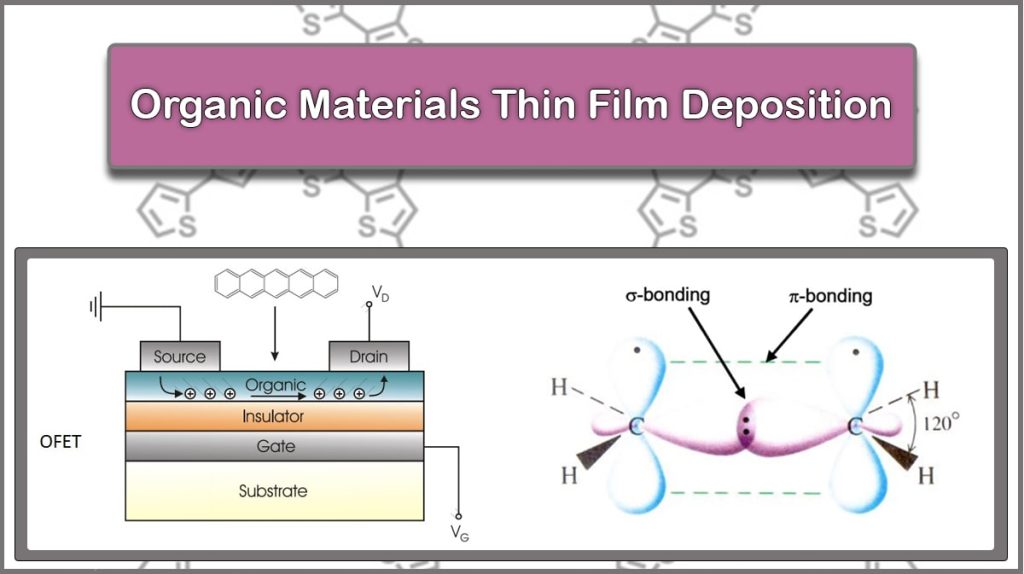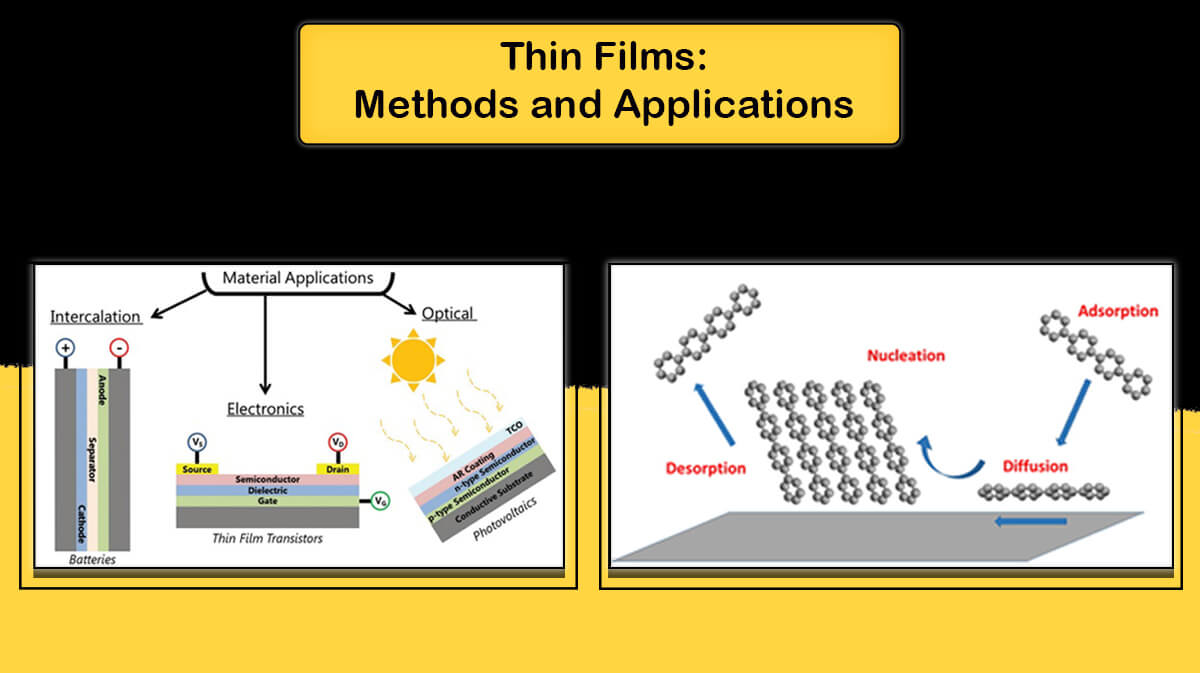Thin Films Deposition of Organic Materials
Electronic components based on thin film organic semiconductors have many applications because of their flexibility and economic large-scale fabrication. These semiconductors allow the creation of electronic devices such as OFET (Organic-Field Effect Transistor), OLED (Organic-Light Emitting Diode), and OPV (Organic Photovoltaic Cell) as a new generation of electronic devices.
What are Organic Materials?
Organic molecules are made up of carbon atoms that are able to make strong covalent single, double, or triple bonds with other carbon atoms or atoms like hydrogen (H), oxygen (O), nitrogen (N), and sulfur (S). These compounds are typically classified as polymers or small molecules and can be found in nature or artificially synthesized. The properties, reactions, and production of such structures are studied in organic chemistry science.
Electronic Structure of Organic Materials
The electronic properties of the organic molecules depend on the bonds between the atoms. The location and properties of these interatomic bonds determine how light is absorbed and the charge transferred by the molecules. The most important of these bonds are the conjugated bonds and how they are joined inside the molecules, where the shared electrons can move within the molecule.
In non-conductive molecules such as polyethylene (Shown in Figure 1), each carbon atom is bonded to the other 4 atoms and all of its electrons are in the valence band and the conduction band in this structure is empty of electrons, so no electron can move freely. On the opposite side are unsaturated bonds that exist in conductive materials. For example, as shown in Figure 1, the structure of polyacetylene contains an additional electron in each carbon atom, which contributes to the electrical conductivity of the molecule.
In large molecules, such as polymers, these electrons traverse along the molecule, and form π junctions. The conducting or semiconducting property of the molecule depends on whether the bonds are full or semi-full. The p-bonding is significantly weaker compared to the s-bonds, which establishes the mechanical strength of the molecule. Then, the π-π*-transitions are the lowest electronic excitations of conjugated molecules with a typical energy gap in the range of 1.5-3 eV, which results in the absorption or emission of light photons in the visible spectral range.
Organic Matter Properties
Bonds in organic semiconductors and inorganic ones are fundamentally different, which have a direct impact on their properties. Reduction of hardness, low melting point, and reduction of electric charge transitions are the characteristics of these materials. The high absorption coefficient of thin layers (Less than 100 nm) of these materials makes it possible to highly absorb light in a way that compensates for their low mobility.
Emergence of Excitons in Organic Materials
Poor electronic displacement of organic semiconductors provides two characteristics for these materials. First is the existence of single and triple spin modes, which is seen in non-conductive materials, and the second is the formation of excitons, which are the light-dependent composition of a pair of electrons and holes. Excitons arise from the collision of light with a photovoltaic molecule. The subtracted photon stimulates the valence bond electron and forms a pair of electron and hole. The energy of the incoming photon must be equal to or greater than the band gap energy of the desired material.
Organic Matter-Based Photovoltaic Cells Advantage
In non-organic photovoltaic cells, an energy of about 0.5 to 1 eV is required to separate this electron-hole pair into positive and negative electric charges so as to generate electric current, in non-organic photovoltaic cells, energy of about 0.5 to 1 eV is required which must be supplied by an external electric field. However, this energy in organic photovoltaic cells is about a few millivolts, which is easily obtained at room temperature.
Formation and separation of excitons is a major process in organic solar cells, which is why they are also called excitonic solar cells.
Organic Materials Deposition
The organic materials can be deposited through solution-based methods or vacuum evaporation. However, due to difficulties in generating long-range molecular order in solution processes like drop coating, they are not as reproducible compared to organic vapor phase deposition by the vacuum evaporation method.
Organic Materials Vapor Phase Deposition
Thermal evaporation deposition is a low-cost and common method used for deposition of the organic materials. Thermal evaporation is used as an efficient and low-cost method in the manufacture of large-scale OLEDs as well as in the manufacture of organic solar cells. Due to the different forms of the molecules, the control of the morphology of the thin film deposited from organic materials is much more complicated than the control of non-organic materials. The type of substrate, the substrate temperature, and the deposition rate in the thermal evaporation process of organic materials must be carefully controlled.
Important Deposition Factors
One of the advantages of the thermal evaporation method is the deposition of complex structures in a single deposition step. The deposition process of organic semiconductors by thermal evaporation has many points in common with the process of deposition by thermal evaporation of non-organic materials but requires more control.
Deposition Chamber Pressure
Many organic materials are degraded in the presence of oxygen or water. As a result, a high vacuum chamber is needed for the deposition of these materials to provide a completely water and oxygen-free environment. Suitable chamber pressure for the thermal evaporation of organic materials shall not exceed 5*10-6 mbars. Vapor pressure is exponentially dependent on temperature and temperature rise rate. Figure 3 shows the evaporative behavior of Alq3 material used in the manufacture of OLEDs.
Evaporation Source
In addition to the evaporative behavior of the materials used, the vapor flux distribution and the thickness of the layers are also important. Creating homogeneous and directional layers is only possible if the mentioned characteristics are fully known. The shape of the sources of evaporation (E.g. boats or baskets) is also important in the proper evaporation of organic materials and in determining the vapor flux distribution. Usually, the suitable sources for evaporation of organic materials are in the form of deep crucibles, especially designed to prevent heat reflection so that the temperature inside the crucible is more homogenous.
The crucible must be made of a reasonably good heat-conductive material to prevent temperature gradient and maintain uniform temperature inside the crucibl to avoid decomposition of organic matter. The materials used in the fabrication of these crucibles are usually aluminum oxide or boron nitride.
Temperature Control
Interatomic bonds in organic materials are weaker than inorganic materials. Therefore, the application of thermal energy breaks more bonds in organic materials. The evaporation temperature of organic materials is often below 500°C. So accurate temperature control of the crucible and the substrate by temperature sensors in the deposition process of organic materials should be considered to prevent the decomposition of organic molecules. It should be noted that precise temperature control is not mandatory in the inorganic materials’ deposition procedure.
Organic Materials Thermal Evaporation Workflow
Deposition of organic materials by thermal evaporation is performed by initially attaining the appropriate pressure and reaching the standby temperature, which is lower than the threshold evaporation temperature. The rate of the increase in the temperature should be as low as possible. Increasing the temperature with a steep slope causes temperature non-uniformity inside the crucible which may cause decomposition of organic matter.
After a short period when the plant is kept at standby temperature, the temperature rises to evaporation temperature in a moderate rate and immediately after the thermal evaporation process is completed, the temperature returns to standby temperature again. Figure 4 shows the temperature rise of Alq3 material.
Organic Matter-Based Devices
Organic materials are suitable alternatives for inorganic semiconductors with advantages like light weight, flexibility, and low fabrication cost. Organic photovoltaic devices (OPVs), organic light-emitting diodes (OLEDs), and organic field-effect transistors (OFETs) are featured electronic and optoelectronic devices based on organic matters that are widely studied nowadays. These organic devices are potential candidates for use in the society of the Internet of Things (IoT).
Fabrication of Organic Matter Devices
The source/drain/gate electrodes or cathode in the optoelectronic devices should be electrically conductive thin films, so one of the main steps in the fabrication of organic matter devices is electrode deposition or metalizing. Deposition of electrical contacts can be performed by various physical vapor deposition methods, including thermal evaporation, e-beam evaporation, and sputtering deposition.
Vac Coat Vacuum Coating Systems
Vac Coat offers coating systems for contact and electrode fabrication using thermal evaporation and sputter coating. Vac Coat high vacuum thermal evaporators are designed with a small chamber (170 mm Dia. and 140 mm Height), named DTE, or a large chamber (300 mm Dia. and up to 400 mm Height), named DTT, to facilitate thin film deposition on substrates with different sizes.
Also, Vac Coat sputter coaters, provided in low vacuum and high vacuum models (DSR1 and DST1), can be used to metalize organic devices with precise thickness control through QCM thickness sensor.
Some of Sputtering and Thermal Evaporation Systems of Vac Coat
References
- Deposition of Functional Organic Thin Layers by Means of Vacuum Evaporation, Jens Drechsel, Hartmut Fröb, 2008 WILEY-VCH Verlag GmbH & Co. KGaA, Weinheim.
- Kovacik, Peter. Vacuum deposition of organic molecules for photovoltaic applications. Diss. Oxford University, UK, 2012. http://www-solar.materials.ox.ac.uk/uploads/images/theses/Peter%20Kovacik,%20DPhil%20Thesis.pdf
- Comparison of organic solar cells and inorganic solar cells, Askari Mohammad Bagher, Department of Physics, Payame Noor University, PO Box 19395-3697 Tehran, Iran.
- Mitzi, David B. “Thin-film deposition of organic−inorganic hybrid materials.” Chemistry of Materials 13.10 (2001): 3283-3298.
- Klauk, H. (2006). Organic Electronics: Materials, Manufacturing and Applications. WILEY-VCH GmbH, 2, 1325-1331.
- Brütting, Wolfgang. “Introduction to the physics of organic semiconductors.” Physics of organic semiconductors (2005): 1-14.
- Shirota, Yasuhiko, and Hiroshi Kageyama. “Organic materials for optoelectronic applications: Overview.” Handbook of Organic Materials for Electronic and Photonic Devices (2019): 3-42.
- https://orgosolver.com/chapters/chapter-1/structure-and-bonding-of-organic-molecules

